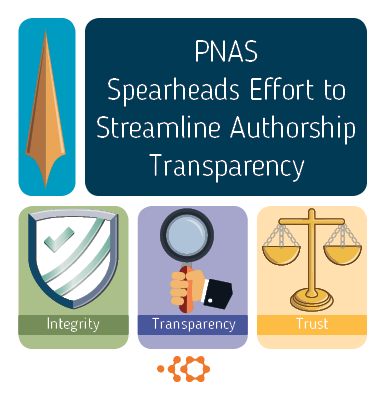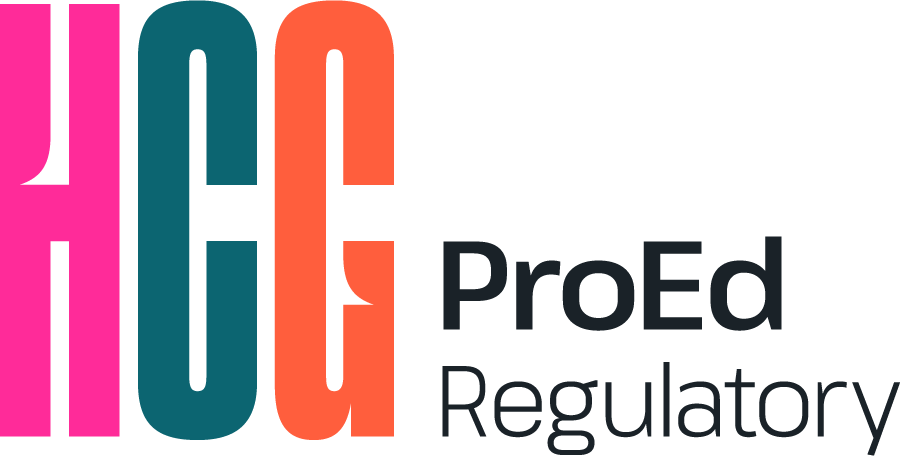PNAS Spearheads Effort to Streamline Authorship Transparency
 Authorship is a hot topic in the scientific and medical publishing world. Who qualifies as an author? Who is the senior author? What are the responsibilities of the corresponding author? Opinions vary across disciplines and cultures. Whereas medical publications generally follow the recommendations of the International Committee of Medical Journal Editors (ICMJE; http://www.icmje.org/icmje-recommendations.pdf),1 academic publications may follow other guidance, or none at all. Is there a way to impose universal authorship criteria and quantify the work of authors so that their actual contributions can be tracked, giving them more than just their name on an article in the modern publish-or-perish environment?
Authorship is a hot topic in the scientific and medical publishing world. Who qualifies as an author? Who is the senior author? What are the responsibilities of the corresponding author? Opinions vary across disciplines and cultures. Whereas medical publications generally follow the recommendations of the International Committee of Medical Journal Editors (ICMJE; http://www.icmje.org/icmje-recommendations.pdf),1 academic publications may follow other guidance, or none at all. Is there a way to impose universal authorship criteria and quantify the work of authors so that their actual contributions can be tracked, giving them more than just their name on an article in the modern publish-or-perish environment?
A recent article by McNutt et al2 in Proceedings of the National Academy of Sciences of the United States of America (PNAS) seeks to create a framework for doing just that. As part of the global push toward greater transparency, with the goal of increasing integrity and trust in scientific publications, this article proposes that journals develop standardized authorship requirements and reporting, documented through ORCID identifiers (https://orcid.org) and the CRediT system (http://docs.casrai.org/CRediT).
ORCID is a digital identification system that creates a unique identifier for each registrant. All authors should register, and all journals should require ORCID identifiers from authors, because it eliminates the question, “Which Dr. Smith is this?”
The Contributor Roles Taxonomy (CRediT) system establishes a standardized set of defined contribution elements (eg, terms such as “conceptualization,” “data curation,” “review & editing”) gleaned by a stakeholder group from real-world authorship contribution disclosures. Selecting from this database makes it possible for authorship contributions to use the same wording and retain the same meaning from journal to journal, rather than forcing the reader to ask questions such as, “What does ‘data management’ really mean?”
If most journals adopted ORCID and CRediT, the unambiguous identity and contributions of authors would be embedded in the article’s metadata. (In the case of the McNutt et al article, for example, the metadata are in footnotes to the title page.) Cultural and discipline-specific differences in senior authorship criteria and responsibility would also be captured regardless of author order. Additionally, when an author is up for promotion, competing for a grant, etc, producing the metadata from published articles would provide a truer snapshot of the author’s research history.
Another possible effect of this proposal, if adopted by most journals, would be to standardize the reporting of authorship contributions and conflicts of interest at submission. If a submission is rejected by one journal, it could be immediately resubmitted to another without reworking this information, eliminating the time currently spent restyling this information to adhere to a new journal’s specific wording requirements.
McNutt et al also adopt the guidance from ICMJE that authorship should be based on (1) substantial contributions to conception/design and/or data acquisition, analysis, or interpretation, (2) crafting and/or substantively revising the work, (3) approval of the final submission, and (4) agreement to be personally accountable for the contributions and agreement to investigate, resolve, and document in the literature any questions about the accuracy/integrity of the work. All 4 criteria must be fulfilled to justify authorship; those who do not meet all 4 criteria typically merit acknowledgment only. Expanding the use of these criteria beyond medical publications would give some disciplines well-defined authorship guidelines for the first time.
Expectations for corresponding authors include maintaining contact with all authors to ensure all have approved the final submitted version, ensuring that all authors receive the full peer reviews and correspondence with journal editors, and ensuring that data, electronic code and software, and other raw materials are archived so that they may be made available to other researchers for reanalysis. Data sharing and experimental reproducibility are vital to ensuring research validity.
To help track adoption of these proposals, the National Academy of Sciences (www.nasonline.org/about-nas/Transparency_Author_Contributions.html) records journals that have made a commitment to universal authorship standards, requiring ORCID and CRediT, and applying other criteria. As of the date of this post, the site includes some fascinating data regarding journals that either wholeheartedly intend to adopt these proposals or strongly oppose them. Only time will tell whether these proposals become new standards or become yet another “modest proposal” to fall by the wayside.
 Ray Hunziker has 20+ years of experience in medical communications editing with ProEd. He is responsible for data verification and style editing of journal manuscripts, posters, slide decks, and interactive pieces. He has also worked on more than 25 regulatory projects (FDA and EMA) and is experienced in editing briefing documents, intelligence reports, and slide presentations.
Ray Hunziker has 20+ years of experience in medical communications editing with ProEd. He is responsible for data verification and style editing of journal manuscripts, posters, slide decks, and interactive pieces. He has also worked on more than 25 regulatory projects (FDA and EMA) and is experienced in editing briefing documents, intelligence reports, and slide presentations.
Reference
- McNutt MK, Bradford M, Drazen JM, et al. Transparency in authors’ contributions and responsibilities to promote integrity in scientific publication. Proc Natl Acad Sci U S A. 2018;115(11):2557-2560. doi: 10.1073/pnas.1715374115.
- International Committee of Medical Journal Editors. Recommendations for the conduct, reporting, editing, and publication of scholarly work in medical journals. 2017. Available at: http://www.icmje.org/icmje-recommendations.pdf. Accessed April 13, 2018.
